Developed by Kevet Duncombe and Jim Battin for the PLATO system at the University of Illinois at Urbana-Champaign
Final Rating: 26
Ranking at Time of Posting: 58/142 (41%)
Raking at Game #404: 198/404 (49%)
 |
| A late game screen shot. Chester has encountered a witch on Level 1 of the "Caves" dungeon. You can see his active spells, equipment, and supplies on the left and his skills on the right. |
If Moria wasn't quite the first computer role-playing game, it was nonetheless unique in that it wasn't based on Dungeons & Dragons. According to author Kevet Duncombe (in a 2007 interview with Matt Barton), neither he nor co-author Jim Battin were even aware of the existence of D&D when they began programming Moria, nor had Duncombe read The Lord of the Rings. Instead, they were inspired by the stories that the authors of The Game of Dungeons told of their development woes and decided to see what they could do with the same concept.
If any of these characteristics feels a bit odd to those used to the D&D paradigm, they are completely overshadowed by the game's innovations. In Moria, we have a lot of firsts: first to require food and water; first to allow dual-wielding; first to assign offensive and defensive ratings to weapons; first to segregate arcane and priestly magic; first to deal with secret doors by having players walk through a blank wall; and first in which groups of adventurers could team up and fight monsters together (in teams of up to 10). There are elements that we see no where else, including the ability to establish a camp for storage of excess gold and food, or the way that instead of inquiring about the cost of everything in a shop, you can tell the shopkeeper how much you want to spend, and he'll make suggestions. Perhaps the neatest element in the game is the ability to "tie a string" to a location and later instantly "follow" it when you want to return to safety--sort of a progenitor of the "mark" and "recall" spells used by later games.
There aren't many choices in character creation. You can choose from among four options, each of which gives a 10 in one skill, 7s in two other skills, and a 5 in the last one, essentially determining the starting "class" of your character (fighter, thief, priest, mage). Nothing prohibits you from using whatever skills you want after creation, though. Every time you use a skill (successfully or not) by tricking (cunning), attacking (valor), praying (piety), or casting a spell (wizardry), there's a small chance that the skill will increase a point. The chance gets smaller the higher the skill level. I imagine it must be impossible to get up to 100 in one character's lifetime; in about six hours of play, I was able to increase cunning by 10 points, valor by 13, piety by 6, and wizardry by 8.
 |
| Creating a new character on the game's main screen. |
Characters age during the game. You start at the tender age of 13 and can theoretically live to 100 before expiring of old age. (If you don't quit your session after dying of old age, you can pass your items to an "heir"--your next character.) Food and water supplies are measured in months, and one month passes for roughly every 8 minutes of game time, irrespective of the number of moves you make. So a full character's life span is a maximum of 139 hours.
Since Moria is a persistent universe with other players, there's no "reloading," though you can stop play and save your character at any point by simply logging off. The game remembers his status and position when you log back in. Death, when it occurs, is permanent.
 |
| The fate of my first three adventurers, before I got the hang of it. |
Combat takes place randomly in the wilderness and dungeons (not in the town) with varied enemies such as zombies, swordsmen, evil priests, reapers, orcs, trolls, dragons, devils, and elementals. The game classifies them into several categories--humanoid, undead, magic users, mythical, animals, elementals, clerics, and "lawful"--but I never really noticed a difference in their abilities or power. I could slay dragons and devils at the outset; enemy difficulty is far more dependent on dungeon level than type of foe.
In combat, you have six options: fight, "trick" (get the enemy to drop his guard for an instant kill), pray for divine intervention (including both healing and instant death for the enemy), cast a spell, "evade" (only useful with other players), bribe the monster to leave you alone, and run. Every action but running draws on the probabilities associated with one of your skills. Combat takes place in quasi-"real time" in that enemies will continue wailing on you if you just stand there when your turn comes up.
 |
| Facing a werelion. Note the combat options at the bottom, including the ability to call for help from other players in the dungeon. |
Both fighting and defending are heavily influenced by the equipment you carry. There are four types of items, all sold in the "weapon" store: weapons, body armor, head armor, and arm armor. Each item has an offensive and defensive rating associated with it, which you can easily assess with the "Inspect" command. (I played the game for a long time before I realized you have to "use" the items you buy and find to equip them. I was wondering why they didn't seem to be doing anything.) Some items require minimum skill scores to use, and if your raise your valor to 30, you can dual-wield weapons.
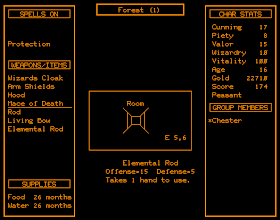 |
| This turns out to be an excellent weapon for both offense and defense. |
The magic system is a little primitive, yet still has some interesting spells. Combat spells are paralysis, charm, sleep, dispel magic, and magic missile. Non-combat spells are light (never had a use for it), pass-wall (very handy when trying to cut through a dungeon), precognition, and protection. There's a separate set of "prayers" (explicitly not called "spells," unlike in D&D) for combat: holy word (when successful, kills enemies instantly), escape, miracle, and "unction" (healing). Outside of combat, you can pray for replenishment of food and water. Spellcasting draws directly from your vitality, so you can't cast too many spells in combat.
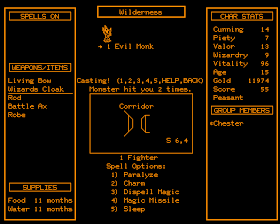 |
| Preparing to cast a spell against an "evil monk." |
 |
| Finding treasure after a combat. |
By far, the more difficult challenge is navigation. The game consists of a town of 48 x 42 squares, a "wilderness area" (with doors and everything, looking just like the town) of 30 x 36 squares, and four dungeons accessible from the wilderness are: caves, forest, desert, and mountains. Each of the dungeons contains 60 levels about as big as the town. The amazing thing is that all of these levels are fixed--the creators must have used some kind of random process to generate them, but they don't change during or between games. With the sizes involved, mapping is almost a necessity, even with the "string" feature. But can you imagine mapping 242 huge areas?
 |
| My map of the "wilderness" area. It hardly makes sense to map the town since there are no encounters there. Once you know where to find the stores and guilds, you're all set. |
Of course, the 242 areas are bereft of any NPCs or special encounters. We're not quite at that era yet. Instead, we get increasingly difficult monsters as we move down the levels. (The game remembers monster placements, too, such that if one character is killed by a monster, he'll still be there when you reload.) The lower the level, the harder the monster, the bigger the treasure, the higher the score for each haul. The explicit goal in the game is to achieve as high a score as possible and impress all your friends. The scoreboard lists the highest scoring player as "Quebec" with an amazing 8,590,248. I can't imagine the dedication that went into that score. In my six hours, I only achieved 448 points.
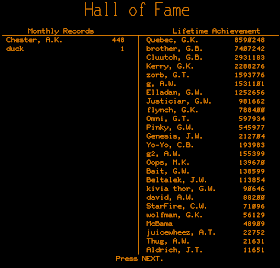 |
| But I made the monthly record! |
Of course, I missed out on a huge part of the gameplay by playing by myself; no one else was logged into the game during any of my sessions, and apparently there was only one other player all month. It's amazing to think that the third CRPG ever created was the equivalent of today's MMORPGs, but the fundamentals were all there. You can adventure as a group, with the maps organized into blocks of 6 x 6 squares in which members can move independently before the guide moves everyone to a new block. In combat, you can talk to your party or "whisper" to a single ally. If caught in a dangerous situation, you can "yell" for someone's help (even if you're not in a group), and other players have the ability to immediately respond (across great distances) to assist. Amazing stuff.
With no way to "win," I set a goal for myself to raise my abilities high enough to join a guild. You need 20 points in cunning to get into the thieves' guild, and the same in their respective skills to get into the Union of Knights, the Brotherhood, or the Circle of Wizards. Once you join, you must continue to develop your skills and donate gold to the guild to rise in rank. Each guild comes with some advantage, such as improved combat skills (fighters) or quick teleportation to other areas (mages). After about six hours of work, I had the requisite skills in both valor and cunning, and I ended up joining the Union of Knights.
The game does set a kind-of goal: to find the Reaper's Ring. Moria's otherwise-excellent documentation is a little hazy here. It says that "the ring starts on Level 1 and moves down a level each time it's found. It may be found on any terrain, so the search may be long and arduous." This suggests to me that when the game was brand new, the Ring was randomly placed on the first level of one of the four dungeons, but it's since migrated downward. Given the number of players over the last nearly-40 years, it seems impossible that it's not on Level 60 somewhere now. Certainly not an achievable goal in any manageable time frame.
Another major goal of the game is to become the master of a guild, which requires 50 in the guild's primary skill. "Master" is the third rank, and going up each rank requries the donation of $5 million, meaning that the player would have to earn $15 million for master level. In six hours of playing, I earned just over $100,000. While I did become mildly addicted to the game--watching the skill points increase incrementally is particularly intoxicating--I don't have that kind of time.
 |
| Do you suppose this means that none of those guilds ever had guildmasters? Or were they removed when their user accounts were deleted? |
A GIMLET score for the game should approximate what I'd give to, say, Telengard or any other game with a bare bones plot in which the driving goal is the accumulation of wealth, the development of a character to higher levels, and the earning of points. In this case, I gave Moria:
- 1 point for the game world. You learn the name of the place and that's about it.
 |
| The "game world" as introduced in the documentation. |
- 3 points for character creation and development. The game's approach to the attributes/skills is unique and fun, and I love that guild membership is tied to the development.
- 0 points for NPC interaction. There aren't any.
- 1 point for encounters and foes. The depth of the encounters is shallow and the enemies aren't well distinguished.
- 3 points for magic and combat. Primitive, but quick and fun.
- 5 points for equipment. A great part of the game. Lots of things to wield and wear, either bought from shops or found among slain enemies' treasures. The game makes it easy to evaluate these items, and there are neat little touches like dual-wielding and skill requirements.
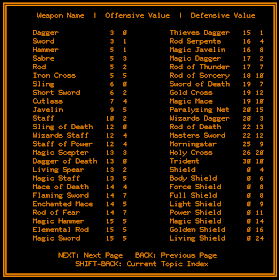 |
| The documentation for the game outlines all the weapons available. |
- 4 points for economy. Earning gold never stops being useful. You need it to rise in guild membership and to buy some of the shockingly expensive items at shops.
 |
| Any chance you have a layaway plan? |
- 2 points for quests. There isn't a main quest, but there are some goals that would be very difficult to achieve.
- 3 points for graphics, sound, and inputs. The graphics are good for the era, especially the little monster icons. No sound, but the keyboard inputs work fine.
- 2 points for gameplay. Though the game is definitely "nonlinear," the enormous dungeon levels, by not containing anything interesting except combats, ultimately become a bit boring.
I'm going to add 2 points for the cooperative multiplayer options and the game's other innovations, such as the "string," for a final score of 26. (As it happens, I gave Telengard a 28, so I was pretty close.) It's an excellent score for such an early game.
 |
| Part of the superb in-game manual |
Oubliette's borrowings from this game (assuming Moria didn't copy Oubliette in a later version) include the WAXD movement keys, the use of a capital "W" to go through a door, the secret door system, the real-time combat approach, and many of the multi-player options, including the use of a leader or "guide." I don't want to overemphasize this, though, because Oubliette introduced greater complexity in the combat, spell, and trap systems. Still, Moria is clearly the origin point for many of the elements we saw well into the Wizardry series, and I'm glad I got to experience it. Let's return to the modern era with Legend of Faerghail.

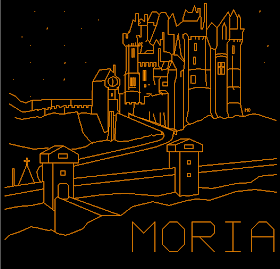

I seem to recall an old shareware Ultima clone called Moria. Was that an entirely different game?
ReplyDeleteMobygames only lists one game called Moria - a Roguelike.
So are there three different games called Moria?
Most likely. I have played the rogue-like called Moria a number of times, and was actually introduced to it by my first girlfriend way back in 1991. It is only slightly different from the actual game, Rogue. It was changed to focus on the Lord of the Rings legends and since it was open source, many later rogue-likes stem from it and its LoTR template rather than from Rogue's background template. I still have a copy of it on my DOSBox directory so I can dive in from time to time.
DeleteWhen I saw this was a review of Moria, I was definitely expecting a different game. Didn't have any idea it wasn't the roguelike called Moria until I read it.
DeleteSame here - I also played Moria. Nowadays its Angband descendants are more popular - I played a good bit of ZangbandTK back in the day.
DeleteOne interesting thing is that Moria the roguelike (and its descendants) also have separate priest and wizard spell lines.
I believe the original Moria was a dungeon in Tolkein, so its possible that games could have got the name independently of each other.
Yes, Moria is the name of a huge underground complex/mine/city constructed by Dwarves in Tolkien's Middle-earth legendarium.
Delete@Deuce Traveler - You're the first guy I've heard of having a girlfriend introducing CRPGs to him. It's the equivalent of having a guy introducing the joys of visiting a nail spa to his girlfirend.
DeleteI too was anticipating Moria (the roguelike) on unix when I saw the title.
Delete@Deuce - It's rare to find a woman who doesn't look at gaming with disgust. I don't even bother trying to explain anything gaming-related to my wife.
DeleteBut you found one who not only plays Roguelikes, but knows more about them than you do? Damn, that girl was a keeper.
Interesting title, I seem to recall that "Moria" was the crusader name for their duchy in Greece, following the 4th crusade in 1204.
ReplyDeleteWell, this one is probably a biblical reference (to the Temple Mount). The game refers to dwarven complex in Tolkien's LOTR.
DeleteI just assumed everyone knew it came from Tolkien. Even for those who haven't read the books, it's quite prominent in the films.
DeleteIt was the "Despotate of the Morea" actually (http://en.wikipedia.org/wiki/Despotate_of_the_Morea), but "Moria" is a village near Mytilene on Lesbos Island.
ReplyDeleteTeehee... you said Lesbos...
DeleteThe funny thing is that Sappho AND the island she lived on have been turned into words for tribadism. Yet the only thing we know for sure about her sex life is that she was married and had a son!
DeleteYou can say the same thing about Alex the Great! XD
DeleteThink of what the PLATO programmers could have done if they'd thought of things like NPCs, dialogue, game lore, and special encounters. Every CRPG lover would be signing up for a Cyber1 account instead of playing the first versions of Wizardry and Ultima.
ReplyDeleteThe same thought has crossed my mind as well. A 70's mainframe computer running PLATO could've supported some spectacularly complex and expansive RPGs compared to what early PCs were able to handle.
But they didn't think of those things before the market put powerful PCs in the hands of other inventive programmers. By 1982 or so we had cheap PCs that were not as powerful as the mainframes, but were powerful enough to support reasonably complex games, and game programming was no longer the preserve of a small elite.
DeleteFanastic glimpse at the foundations of fantasy MMORPG being laid at such an early date. Before I read Barton's Dungeons & Desktops, I believed CRPGs started on the first home computers, so that was one revelation, but getting more filled in (Moria --> Oubliette --> Wizardry) and these detailed glimpses of the actual mainframe era games is fascinating. Stuff in Moria like being able to send player-wide calls for help is mind-blowing.
ReplyDeleteAgree it's intriguing to think of what would have happened if these games had continued to evolve on their own, hyper-powered-compared-to-home-computers track.
Random thoughts...
DeleteWhy didn't they continue to evolve? Is it because the drive to turn a game profitable was a bigger draw than creating a grand vision? Maybe the lack of control on the database also drove developers to make programs on their own systems.
That probably had something to do with it. Also, the audience was very limited, consisting only of college students with access to the PLATO mainframe.
DeleteStill, it's not quite true to say that they didn't continue to develop. Many of the games on PLATO were still developed well into the 1980s. I need to find someone experienced with writing for PLATO to talk about its limitations, of which there might be some.
I'm pretty sure many frowned upon using such powerful systems for something as trivial as a 'game'. I do know that often games had to be hidden, so to speak, so that unsympathetic admins didn't delete them and that certain pieces of software were written to limit/regulate access to games on PLATO systems. Games and chat/IM software were the bane of many a PLATO system admins.
DeleteI suspect that must've been a pretty major roadblock towards the creation of any sort of 'grand vision'. And, of course, as Chet says, the number of people involved in playing and especially writing games was very limited.
I'm trying to find the relevant e-mail or post, but I'm pretty sure I heard from a PLATO developer at one point who said that, yes, at the beginning, games weren't allowed, which is why the first known RPG ('m119h") and pedit5 were ultimately deleted. Later, the attitude seems to have been well, at least they're learning how to program. Everything created after 1975 seems to have survived fairly well.
DeleteI would say they did continue to develop from mainframes to BBS's to muds to mmorpgs.
DeleteThis game reminds me of a pay-to-play game I played in early 90s. It was more of a MUD though on the Prodigy network.
ReplyDeleteReminds me of the original Neverwinter Nights, though that was only AOL.
DeleteI thought the original Neverwinter Nights started on prodigy before it was on aol.
Deleteduck made a respectable 2nd place in the Monthly Top Adventurers with an astounding score of... 1?!?!
ReplyDeleteI think you get that just for creating a character.
DeleteJust like SATs. XD
DeleteLove these PLATO game reviews. I also love your new plan. Thanks so much for being our guide through CRPG history!
ReplyDeleteHad to chuckle at this...
"Given the number of players over the last nearly-40 years, it seems impossible that it's not on Level 60 somewhere now. Certainly not an achievable goal in any manageable time frame."
... says the man who managed to ascend in Nethack! :^D
True, but NetHack had only 30 levels and interesting things happening on all of them. Moria has 240 levels of relatively boring content.
DeleteOr 50, I guess.
DeleteIn the Hall of Fame picture.. what are those initials after (almost) everyone's names? I get the sense that they aren't just initialed first/middle names, since yours doesn't say "Bolingbroke, C.?."
ReplyDeleteI will guess it's a guild designation. Apprentice Knight possibly? It's fun guessing... ;)
DeleteYes, that's what it is. And "G" must be "Guildmaster," so those other guilds did have guildmasters at one point. Maybe there's a time limit, or just those user accounts got deleted.
DeleteSeems like this might be the first MUD. I remember spending way too much time telneting into a nearby college's bbs to play a version of Crimson MUD. Also super excited for LoF a friend had this and I thought it was the coolest thing. There was a weird bug that I'm curious if you'll stumble upon.
ReplyDeleteThere does seem to be very little to distinguish RPG from MUD on these early mainframes.
DeleteI'm just excited we've finally reached Faerghail! I remember this game being amazing, I can still hum the intro music to this day. Of course, that was on the Amiga, so the DOS version may not have it. Either way, it's hopefully as good as I remember.
ReplyDelete-BelatedGamer
Well....I'm not sure you're going to like my first post. That doesn't mean it won't get better.
DeleteOuch. Well, I suspected my love for the game may mostly be nostalgia. Ah well, I can live with that. Hopefully you get some degree of satisfaction from it.
Delete-BelatedGamer
I kind of poked at it recently via Abandonware and couldn't get into it. That just means I couldn't get into it, not that it's bad.
DeleteWhen I played Faerghail back in the days on the ST, I felt it was extremely average and little more than a Bard's Tale clone. Very repetitive is what stuck in my mind.
ReplyDeleteVery enjoyable read. I'm studying CS at UIUC right now. There's PLATO stuff everywhere. These aren't the accomplishments that are emphasized, howver :)
ReplyDeleteAnother apparent first for Moria, and something Oubliette apparently copied from it, is the monster types. That probably seems like a minor thing, but I think it's kind of interesting in that, like I said in a comment on the Oubliette post, D&D 3E years later not only used monster types but used many of the same names for them (animal, elemental, humanoid, undead)... though, again, I'm not claiming D&D 3E actually took the idea from Moria or Oubliette; it's certainly a concept that could be arrived at independently. (Though now I'm kind of wondering if any of the D&D 3E designers went to UIUC...)
ReplyDeleteI probably didn't highlight it, but those monster categories were listed all the way back in the first extant PLATO RPG, "pedit5" or The Dungeon, which listed them as "evil men," "goblin-types," "monstrous animals," "undead," and "mythical creatures." So I'm guessing that The Dungeon was influenced by D&D, The Game of Dungeons was influenced by The Dungeon, and Moria was influenced by The Game of Dungeons.
DeleteHuh, I was just reading about the trick they use to make those dungeons. At least, what i assume is the trick. You write a random dungeon generator, then use a set seed instead of a random one (So you always get the same sequence of 'random' numbers in the same order.) Then you get 'random' levels that are the same each time. Elite uses the same trick to generate universes. Today Dwarf Fortress uses a similar trick, so that users can share worlds with one another.
ReplyDeleteLate for this but. If you go on the cyber1 network into either vavatar or zavatar, you will find plenty of programmers and players from way back when to answer questions and provide insight I suppose.
ReplyDeleteOK,didn't see the don;t use "Anonymous" post until after I posted.
ReplyDeleteNo problem. It's more of a request than a rule.
DeleteI "completed" Moria recently - by finding the Reaper's Ring, which was the goal I set for myself - and thought I'd drop over here to leave some comments. It took me about 8 months of solid playing, so you made the right call as far as abandoning this one after 6 hours.
ReplyDelete* Getting a Score of 100 for any stat should be doable within a character's lifespan. My last character had a Valor of 90 when I finished, and he was around 50 years old. I don't think characters start dying of old age until they hit 100.
* The string feature isn't all that useful, as it doesn't work between dungeon levels. It also gets "cut" occasionally by monsters. The ability to set a camp and then teleport to it from your guild is much better, especially in conjunction with the wizard's ability to teleport back to town. You can also find amulets that give that same ability to members of the other guilds.
* The Light spell allows you to see secret doors.
* Regarding the Reaper's Ring, it did start on Level 1, and it does drop a level and transport to a random dungeon every time it's discovered. From what I read in the game's note files, it was restarted on Level 1 when the game was launched on Cyber1 in 2001. I found the Ring on Level 50, tucked away in an area that was only accessible with a Passwall spell.
* The Reaper's Ring isn't that impressive - it just gives you 100,000 points and knocks five years off your age before it disappears. Given that my character spent forty years of his life looking for the bloody thing, he should be pretty pissed off.
* Gold does eventually stop being useful, at least in a single-player game. The rewards get very large on the deeper levels, and once you've become a Guild Master and bought all of the best weapons and armour (as well as spares for your heir, just in case) there's not much else to do with it except store it in the bank. In multi-player you could always gift it to other players, or use it to bail fellow guild members out of prison.
* There's a secret fifth dungeon called The Ocean. It's underwater, and you can't survive in there without Magic Gills. It doesn't kill you instantly, you just lose Vitality with every step. There's no reason to go in there though, it just has a few different monsters. The Reaper's Ring apparently never shows up in it either. The way to find it is to go to the far north-west of the Wilderness and cast a Passwall through the north or east wall.
In a way you were right about the game being too easy - after a while combat becomes pretty much a foregone conclusion as long as you're patient. The real obstacle is the game's size, which makes searching for the Ring rather onerous. I was lucky enough to find a map that would alert me to the presence of stairs, which made descending the dungeons a lot quicker. I had to descend to level 50 of all four to find the Ring, but with the map I could just "lawn-mow" through the 6x6 blocks and get down there in a matter of hours. All told, it wasn't really 8 months well spent, but at least I have the satisfaction of having beaten it.
This article made me want to try this game. I got my login and everything, but when I type "moria" and then hit DATA it kicks me back to the lesson menu :(
DeleteCapital WAXD goes through doors in dnd from 1975 (also on PLATO, and the second earliest surviving CRPG after pedit5)
ReplyDeleteInteresting, just happened upon this site and would like to get in touch with the writer of this article. Dunc and I may have some in-sights for you.
ReplyDeleteThanks
Jim Battin
Hi, Jim! I'd be happy to hear your insights, and to talk in general about designing games for PLATO. You can always reach me at crpgaddict@gmail.com.
Delete--Chet Bolingbroke
Hello Chet. Did you get the chance to talk to the authors? It would be exciting if you did.
DeleteNo. I guess I expected him to reply to this comment or contact me. I should reach out to him proactively.
Delete